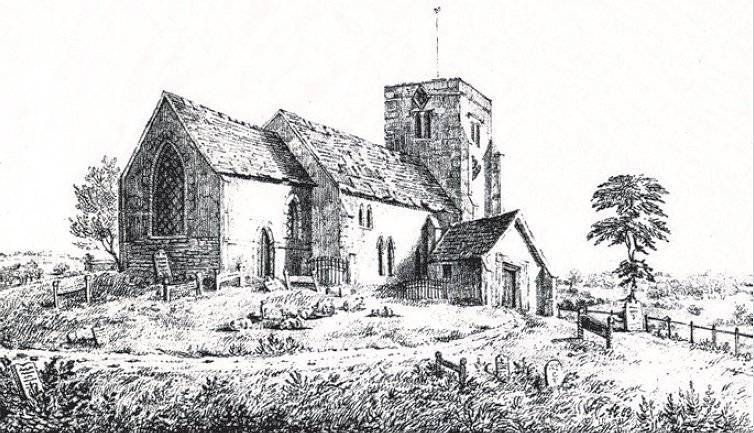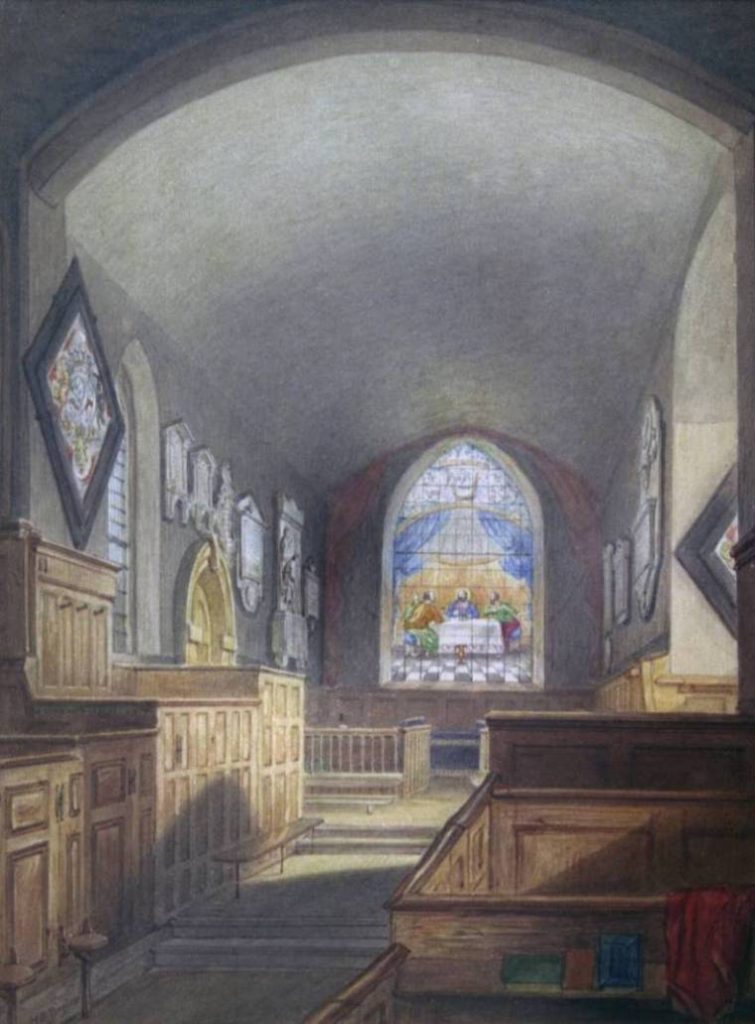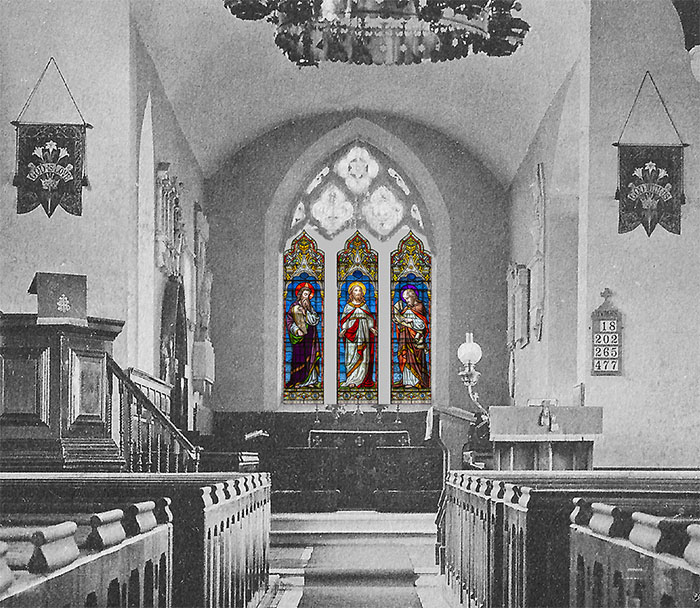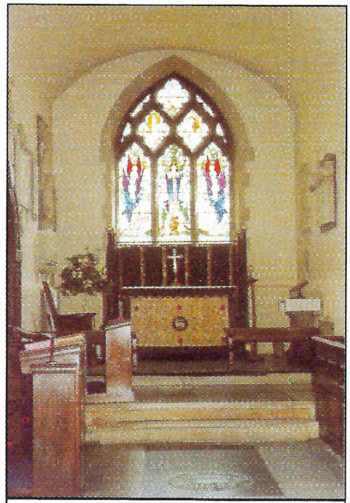There is currently a controversy over the removal of the altar’s riddel posts, side curtains and dossal (rear curtain) and the move forward of the altar to allow the priest to stand behind it facing the congregation in the nave. In past centuries, passionate argument on these and allied subjects have contributed to the Civil War and the execution of an Archbishop of Canterbury, as well as landing a former Vicar of Penn in Aylesbury gaol.
Part One – Medieval – The Catholic church
The controversy stretches back many centuries. The preReformation Catholic Church gave absolute primacy to the altar. It was not an accessory but rather the church was more the shelter for the altar, often called Christ’s Board or God’s Board. From shortly before the Conquest, wooden altars, such as we now have in Penn, were banned. A stone altar on stone supports or legs was required, made of a single slab (known as the mensa or table) symbolising the unity of the Church and the oneness of her belief. It was always incised with five crosses, one on each corner and one in the centre (as is Penn’s wooden altar), symbolising the wounds of Christ. There was sometimes a cavity for the reliquary containing the holy relic, fragments of a saint’s body or possessions, proudly preserved by every church. (Just possibly St Paul for Penn and hence Pauls Hill and Old Pauls Farm).
The medieval chancel was separated from the nave by a carved wooden Rood-screen in order to increase the sense of the chancel as a holy place. The altar was the focus of the church, the Holy of Holies, where the priest, with his back to the congregation, performed the secret part of the Mass, the mystery of transubstantiation by means of which the bread and wine were transformed into the actual body and blood of Christ. ‘Rightly performed secretly‘, said Durandus, a 13th century French bishop and Papal Legate, ‘because man can in no wise fully comprehend so great a mystery‘. The priest was seen as the indispensable intermediary between God and His people, addressing prayers to God on their behalf. The parishioners generally only took communion themselves once a year at Easter following their obligatory annual confession. For the rest of the year, they were spectators, alerted by the ringing of the sacring bell and eager for the sight of the Host in the raised hands of the priest, which was fervently believed to bring them God’s blessing.
In the first centuries after the Conquest, the altar, largely unadorned, stood out well away from the east wall, both to emphasise its dignity and significance and to allow the bishop to walk around it to touch each cross with holy oil during the act of consecration. Later, the altar was moved back against the east wall of the chancel and was often increasingly dominated by an elaborate altar-piece and reredos behind and above it, with more and more ornaments such as candlesticks reliquaries and church plate, piled on to the altar itself. In smaller parish churches, like Penn, the long east window, almost down to the altar, formed the reredos.
We know from an inventory of church goods, in July 1552, that Penn’s altar cross was flanked by ‘great candelstikes with other brasse‘, and that the Reserved Sacrament (the consecrated bread reserved for the sick and the dying) in a (probably silver) pyx covered with a costly fabric, hung above it, with banners overhead. Canon Law also required a statue of the Virgin and the patronal image, in our case that of the Trinity (represented elsewhere by the image of an old man, a crucifix and a dove), in a curtained niche in the wall on each side.
16th Century The Protestant Reformation
The Protestant view was quite different. They rejected the need for a sacriicial altar with a priest as an intermediary, arguing that Christ had already made His sacrifice for us all. They were nervous about kneeling to take communion in case they were accused of worshipping the bread and wine as the actual body and blood of Christ. They believed this to be ‘an Idolatry to be abhorred of all faithful Christians‘ on the very practical grounds that He was already in Heaven and so could not ‘be at one time in more places than one’. Thus, in 1552, Edward VI’s Privy Council ordered the abolition of all stone altars and the first Protestant Prayer Book of 1552 removed any idea that communion could be celebrated by a priest for a watching congregation, but only when ‘there be a good nombre to celebrate with the priest‘. Communion was to be celebrated by a priest wearing neither cope nor vestment, but a simple surplice like the parish clerk or the choir. The celebration was to take place not at God’s Board but at a table set in the body of the church, the priest standing on the north side, and any unconsecrated bread or wine left over was to be taken home by the curate for domestic consumption. All trace of association with the priest before the altar at Mass was removed. The Commissioners who inspected every church to ensure compliance were instructed to leave only a cup, a bell, a covering for the table and a surplice.
In 1539, after Cromwell had issued a set of Royal Injunctions radically changing practice and ritual, the vicar I of Penn was put in Aylesbury gaol, on account of the utterance by him of certain opprobrious words’. His accusers may well have been his two churchwardens.
What a precedent!
In 1553, with Mary now on the throne, stone altars and Catholic ritual were restored, but only for five years because she was then succeeded by the Elizabeth, whose commissioners ensured a suppression of the externals of Catholicism over the twenty years. The consequence of this Protestant zeal for destruction, the disparagement of outward forms and sacraments and the teaching that religion was rather a matter for individual communion between man and God was that many people disregarded their obligation to keep their parish church in good repair, especially chancels. In 1603, Queen Elizabeth wrote to the bishop of Lincoln that she ‘had been informed that divers churches and chancels were greatly decayed and were either fallen down, or were like to fall down’.
Penn’s chancel is particularly likely to have been neglected because the Penn family, the lay rectors who were responsible for it, remained Catholic for nearly a century after the Reformation. Attendance at church was compulsory with fines for non-attenders, but only 120 people, about half the population of the parish, were recorded as communicants in 1603.
© MIles Green, May 2003





